Chlorination increased around 1991 and the increase in cancers can be seen in the graph on the left. Simultaneously the incidence of heart attacks (graph on the right) went up and, of particular note, the increase in heart attacks was more pronounced than the increase in cancers.
The effect of chlorination on heart attacks is related to cholesterol. As the hypochlorous acid produced by chlorination is an oxidising agent, the body's defence is antioxidants. Antioxidants are fruits and so on which contain vitamin C but the dose of residual chlorine added to water, while very small, is so many times greater than our bodies were designed to cope with. Our livers are able to produce cholesterol as an antioxidant and this cholesterol leads to blockage of the coronary arteries and the type of heart attack called ischaemic heart failure. "Ischaemic" refers to the lack of oxygen to the heart muscle.
Research into the effect of chlorination on cholesterol has been done by Revis et al and this research has shown an additional effect related to chemical water treatment.
Chlorine and cholesterol
Using Carneau pigeons as test subjects, Revis et al found that chlorine had an effect on cancer. Their research showed that T4 was affected by chlorination. T4 is thyroxine and changes to the level of T4 correlate with increased risk of cancer. This is in line with epidemiology by Yang et al and others.
In addition, Revis et al found that chlorine had an effect on cholesterol. Their article can be found here. In particular Revis et al found that "significant increases in plasma cholesterol after 3 months of exposure were only observed in pigeons given chlorine at pH 8.5 (2 and 15 ppm)." The greatest effect was seen with a pH of 8.5, a low cholesterol diet and chlorine at 2 ppm.
The factor of water pH has a big effect on cholesterol and, therefore, heart attacks. When chlorine is added to water it produces hydrochloric acid which is corrosive on pipes and plumbing fittings. To counteract this corrosive effect from excess acidity, lime is added to chlorinated water to force the pH alkaline. Revis et al showed that plasma cholesterol is greatly increased when chlorination and lime adjustment are used together, which they invariable are in water treatment plants. My own research has demonstrated that when lime is not added, or sodium hydroxide is used in its place, that the incidence of cancer is around 30% less than would otherwise be the case.
Hypochlorous acid formed by chlorination is an oxidising agent and it removes an electron from DNA. This is where carcinomas start.
Oxidation and damage to DNA
Hypochlorous acid is an oxidising agent and it removes an electron from DNA. The lost electron is replaced by an adjacent electron and this process continues along the DNA until an electron is taken from a guanine component of the DNA. This process is called "electron hole migration" and when it stops at a guanine this sets the stage for carcinomas.
Kanvah et al have described the electron hole migration process in their article "Oxidation of DNA: Damage to Nucleobases."
The removal of the electron is often from a carbon in the guanine component of DNA, for example from the C8 carbon as illustrated:
The effect of chlorination on heart attacks is related to cholesterol. As the hypochlorous acid produced by chlorination is an oxidising agent, the body's defence is antioxidants. Antioxidants are fruits and so on which contain vitamin C but the dose of residual chlorine added to water, while very small, is so many times greater than our bodies were designed to cope with. Our livers are able to produce cholesterol as an antioxidant and this cholesterol leads to blockage of the coronary arteries and the type of heart attack called ischaemic heart failure. "Ischaemic" refers to the lack of oxygen to the heart muscle.
Research into the effect of chlorination on cholesterol has been done by Revis et al and this research has shown an additional effect related to chemical water treatment.
Chlorine and cholesterol
Using Carneau pigeons as test subjects, Revis et al found that chlorine had an effect on cancer. Their research showed that T4 was affected by chlorination. T4 is thyroxine and changes to the level of T4 correlate with increased risk of cancer. This is in line with epidemiology by Yang et al and others.
In addition, Revis et al found that chlorine had an effect on cholesterol. Their article can be found here. In particular Revis et al found that "significant increases in plasma cholesterol after 3 months of exposure were only observed in pigeons given chlorine at pH 8.5 (2 and 15 ppm)." The greatest effect was seen with a pH of 8.5, a low cholesterol diet and chlorine at 2 ppm.
The factor of water pH has a big effect on cholesterol and, therefore, heart attacks. When chlorine is added to water it produces hydrochloric acid which is corrosive on pipes and plumbing fittings. To counteract this corrosive effect from excess acidity, lime is added to chlorinated water to force the pH alkaline. Revis et al showed that plasma cholesterol is greatly increased when chlorination and lime adjustment are used together, which they invariable are in water treatment plants. My own research has demonstrated that when lime is not added, or sodium hydroxide is used in its place, that the incidence of cancer is around 30% less than would otherwise be the case.
Hypochlorous acid formed by chlorination is an oxidising agent and it removes an electron from DNA. This is where carcinomas start.
Oxidation and damage to DNA
Hypochlorous acid is an oxidising agent and it removes an electron from DNA. The lost electron is replaced by an adjacent electron and this process continues along the DNA until an electron is taken from a guanine component of the DNA. This process is called "electron hole migration" and when it stops at a guanine this sets the stage for carcinomas.
Kanvah et al have described the electron hole migration process in their article "Oxidation of DNA: Damage to Nucleobases."
The removal of the electron is often from a carbon in the guanine component of DNA, for example from the C8 carbon as illustrated:
The reference to CHMs and NCHMs is to chlorinated municipalities and non-chlorinated municipalities.
The example above is for men and the evaluation of cancer risk is made by odds ratio (OR). An OR of 1.0 means no increased risk whereas an OR of 1.60 (male smokers from the chart) shows that the lung cancer risk for male smokers is 60% higher if they drink chlorinated water. Risk of cancer of the kidney is 151% higher, cancer of the pancreas is 49% higher and so on.
The EPA refers to the research by Yang et al (and other similar recent research) and has come to the conclusion that chlorination should be phased out. I quote from the EPA entry in the United States Federal Register, Vol.68, No. 159, 18 August, 2003:
"Chlorine has been widely used as a chemical disinfectant, serving as a principal barrier to microbial contaminants in drinking water. However, the microbial risk reduction attributes of chlorination have been increasingly scrutinized due to concerns about potential increased health risks... new health studies continue to support an association between bladder, colon and rectal cancers from long-term exposure to chlorinated surface water. In addition to cancer effects, recent studies have reported associations between use of chlorinated drinking water and a number of reproductive and developmental endpoints including spontaneous abortion, still birth, neural tube defect, pre-term delivery, low birth weight and intrauterine growth retardation (small for gestational age)...
Based on the weight of evidence from both the human epidemiology and animal toxicology data on cancer and reproductive and developmental health effects and consideration of the large number of people exposed to chlorinated byproducts in drinking water (approximately 254 million), EPA concludes that: (1) Current reproductive and developmental health effects data support a hazard concern, (2) new cancer data strengthens the evidence of an association of chlorinated water with bladder cancer and suggests an association for colon and rectal cancers, and (3) the combined health data warrant regulatory action..."
So there is official recognition of the connection between chlorination and carcinomas. As yet that recognition has not extended to recognising the main disinfectant produced by chlorination, hypochlorous acid, as carcinogenic and is limited to chlorination by products (DBPs) formed by the interaction of chlorination with organic matter in the water or in the digestive tract.
A chlorine residual is added to drinking water and it is this residual which becomes a mixture of hypochlorous acid and hydrochloric acid. Hypochlorous acid is regarded as "harmful to host" as it is a disinfectant which damages human cells by a process called oxidation. The immune system does actually use hypochlorous acid but it is as a last resort when all else has failed. I refer to an article by Pennathur et al who state that, "HOCl and its conjugate base (OCl-) are potent oxidants that function as powerful antimicrobial agents. However, the properties of HOCl that make it such a potent antimicrobial agent may also endanger the host, as it can damage the host tissue by the same mechanism used to destroy invading pathogens... HOCl is implicated as a contributing factor in a number of pathological conditions including inflammatory diseases, atherosclerosis, respiratory distress, acute vasculitis, rheumatoid arthritis, glomerulonephritis and cancer..."
It is quite wrong to promote chlorination as a safe water treatment practice or to continue to use chlorination when a safe and economical alternative exists.
An example of chlorination and its effect
Chlorination has usually been introduced one water supply at a time so the effect on cancer rates is gradual over some years when a country is viewed as a whole. Occasionally there is an increase in chlorination which is country wide and sudden. Venezuela is such an example. Chlorination was increased in response to an outbreak of cholera in South America. There are two effects to be seen so I have mapped both:
The example above is for men and the evaluation of cancer risk is made by odds ratio (OR). An OR of 1.0 means no increased risk whereas an OR of 1.60 (male smokers from the chart) shows that the lung cancer risk for male smokers is 60% higher if they drink chlorinated water. Risk of cancer of the kidney is 151% higher, cancer of the pancreas is 49% higher and so on.
The EPA refers to the research by Yang et al (and other similar recent research) and has come to the conclusion that chlorination should be phased out. I quote from the EPA entry in the United States Federal Register, Vol.68, No. 159, 18 August, 2003:
"Chlorine has been widely used as a chemical disinfectant, serving as a principal barrier to microbial contaminants in drinking water. However, the microbial risk reduction attributes of chlorination have been increasingly scrutinized due to concerns about potential increased health risks... new health studies continue to support an association between bladder, colon and rectal cancers from long-term exposure to chlorinated surface water. In addition to cancer effects, recent studies have reported associations between use of chlorinated drinking water and a number of reproductive and developmental endpoints including spontaneous abortion, still birth, neural tube defect, pre-term delivery, low birth weight and intrauterine growth retardation (small for gestational age)...
Based on the weight of evidence from both the human epidemiology and animal toxicology data on cancer and reproductive and developmental health effects and consideration of the large number of people exposed to chlorinated byproducts in drinking water (approximately 254 million), EPA concludes that: (1) Current reproductive and developmental health effects data support a hazard concern, (2) new cancer data strengthens the evidence of an association of chlorinated water with bladder cancer and suggests an association for colon and rectal cancers, and (3) the combined health data warrant regulatory action..."
So there is official recognition of the connection between chlorination and carcinomas. As yet that recognition has not extended to recognising the main disinfectant produced by chlorination, hypochlorous acid, as carcinogenic and is limited to chlorination by products (DBPs) formed by the interaction of chlorination with organic matter in the water or in the digestive tract.
A chlorine residual is added to drinking water and it is this residual which becomes a mixture of hypochlorous acid and hydrochloric acid. Hypochlorous acid is regarded as "harmful to host" as it is a disinfectant which damages human cells by a process called oxidation. The immune system does actually use hypochlorous acid but it is as a last resort when all else has failed. I refer to an article by Pennathur et al who state that, "HOCl and its conjugate base (OCl-) are potent oxidants that function as powerful antimicrobial agents. However, the properties of HOCl that make it such a potent antimicrobial agent may also endanger the host, as it can damage the host tissue by the same mechanism used to destroy invading pathogens... HOCl is implicated as a contributing factor in a number of pathological conditions including inflammatory diseases, atherosclerosis, respiratory distress, acute vasculitis, rheumatoid arthritis, glomerulonephritis and cancer..."
It is quite wrong to promote chlorination as a safe water treatment practice or to continue to use chlorination when a safe and economical alternative exists.
An example of chlorination and its effect
Chlorination has usually been introduced one water supply at a time so the effect on cancer rates is gradual over some years when a country is viewed as a whole. Occasionally there is an increase in chlorination which is country wide and sudden. Venezuela is such an example. Chlorination was increased in response to an outbreak of cholera in South America. There are two effects to be seen so I have mapped both:
cancer.net.nz
-keeping you informed with totally independent cancer research-
-keeping you informed with totally independent cancer research-
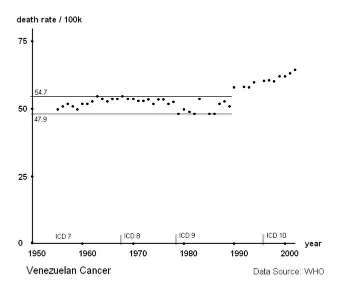
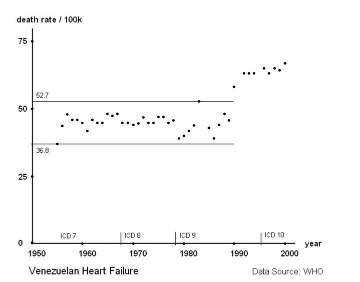
Stephen G. Butcher
email contact: sphlat@actrix.co.nz
email contact: sphlat@actrix.co.nz
My thanks to the developers of the following software:
Easy Graphic Converter 1.2
JPEGCompress 2.7
Jpegcrop 2004.06
Atlantis Nova 1.0.0.68
JPEGCompress 2.7
Jpegcrop 2004.06
Atlantis Nova 1.0.0.68
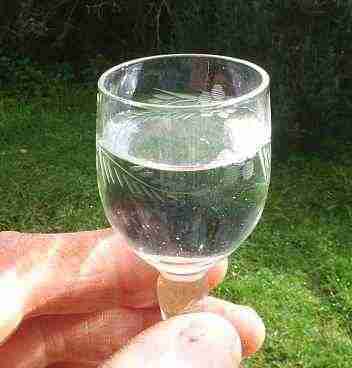
(Completely revised 07/03/14)
The cancer epidemic we have today affects a great many people. There is hardly anyone who is not affected in some way - either directly or indirectly. This has not always been the case. The epidemic began in earnest around 1950 and only affects some countries. It is "switched on" by the chlorination of drinking water, is man-made and is totally preventable.
Chlorination causes damage to our cells and this is the starting point for a particular class of cancers called carcinomas. Carcinomas are cancers of the epithelial tissues, and mainly affect the kidney, bladder, lung, pancreas and rectum.
The cause of the epidemic has now been recognised by the Environmental Protection Agency (EPA) in the United states. Filtration is now recommended as an alternative to chemical dosing. As drinking water suppliers progressively change to this new method of water treatment, the epidemic of carcinomas is coming down. There is still considerable reluctance by some water suppliers, usually local authorities, and by some governments to accept that the case against chlorination is now beyond doubt. Unfortunately this delay is continuing the needless loss of life and associated harm from the practice of chlorination.
Chlorination causes damage to our cells and this is the starting point for a particular class of cancers called carcinomas. Carcinomas are cancers of the epithelial tissues, and mainly affect the kidney, bladder, lung, pancreas and rectum.
The cause of the epidemic has now been recognised by the Environmental Protection Agency (EPA) in the United states. Filtration is now recommended as an alternative to chemical dosing. As drinking water suppliers progressively change to this new method of water treatment, the epidemic of carcinomas is coming down. There is still considerable reluctance by some water suppliers, usually local authorities, and by some governments to accept that the case against chlorination is now beyond doubt. Unfortunately this delay is continuing the needless loss of life and associated harm from the practice of chlorination.
And here it is. A glass of tap water. The biggest killer of our time. While it may seem obvious that adding dangerous chemicals to our water is going to have a detrimental effect, the extent of that affect may not be so clear. Certainly Government in its many forms is often quick to deny any harm from chemically treated water and part of the success of that approach is the lack of accessible peer reviewed scientific research demonstrating the contrary. On these pages I have links to some of those papers as they apply.
Chlorinated v unchlorinated water supplies
Yang et al, researchers at the Kaohsiung Medical College in Taiwan, made a comparison between chlorinated and unchlorinated water supplies in Taiwan. The results of their research were published as a paid article, and in the interests of freedom of information I have provided a link to a paid copy of their article. In the interests of royalties, if you wish to download please do so from a web site which sells this article.
This is one of the articles which the EPA refers to. Yang et al quote some of the research prior to their work and in many ways Yang et al have been in a better position, with the wisdom of hindsight, to arrange their study in a way which overcomes some of the limitations of previous studies.
Yang et al found not only a clear correlation between chlorination and cancer but also identified the cancers by site, i.e. by organ in the body. This shows very clearly that the cancers which are affected by chlorination are carcinomas.
Chlorinated v unchlorinated water supplies
Yang et al, researchers at the Kaohsiung Medical College in Taiwan, made a comparison between chlorinated and unchlorinated water supplies in Taiwan. The results of their research were published as a paid article, and in the interests of freedom of information I have provided a link to a paid copy of their article. In the interests of royalties, if you wish to download please do so from a web site which sells this article.
This is one of the articles which the EPA refers to. Yang et al quote some of the research prior to their work and in many ways Yang et al have been in a better position, with the wisdom of hindsight, to arrange their study in a way which overcomes some of the limitations of previous studies.
Yang et al found not only a clear correlation between chlorination and cancer but also identified the cancers by site, i.e. by organ in the body. This shows very clearly that the cancers which are affected by chlorination are carcinomas.
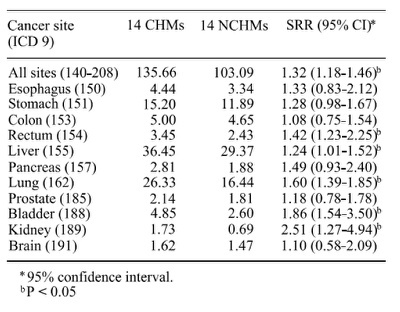
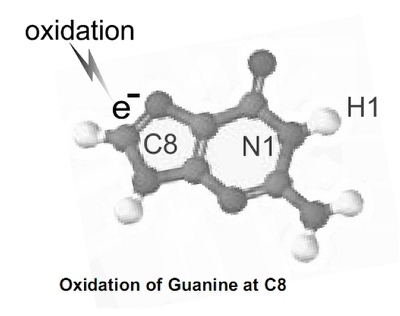
Once this electron has been removed, the damaged DNA can be repaired, killed by the immune system or progress to cancer. In order to progress to cancer, an OH (oxygen-hydrogen) component is added in.
The removal of the electron from DNA is called "oxidation" and the addition of the OH group (an hydroxyl) is called "reduction." The reduction process is still the subject of research as researchers seek to explain how this process of reduction occurs in a way which releases energy to make the process happen. The addition of the OH must lose energy. If it were to require energy then it would be impossible for the addition to occur.
The reduction process after oxidative damage to DNA
Now it should be remembered that the case against chlorination has been proved. There can be no doubt that chlorination is the root cause of the cancer epidemic and that fact is not compromised by the research which currently seeks to follow the process that occurs at the detail of DNA which is still not fully understood. This should not stand in the way of immediate corrective action in shifting from chlorination to filtration alone.
One proposal for the source of the energy to allow reduction to occur is that put forward by Barnett et al and Kanvah et al who propose the involvement of a sodium counterion.
My view is that this does not explain the frquency with which reduction occurs and given the effect of pH adjustment I am of the opinion that hydronium is the more likely to be involved.
Further, when hydronium formed by lime adjustment of pH passes through metal water pipes it can be affected by ionisation of those pipes in a way which imparts energy to the hydronium. This energy is then able to be released in the reduction process.
Water pipe ionisation
Metal water pipes are grounded at a consumer's meter board but not at the supply transformer. That is, mains power neutral is connected to water pipes in homes and businesses but the supply transformer neutral is not connected to metal water mains. The process of connecting water pipes to electric power neutral is called "equipotential bonding." Where this bonding is incomplete, as it is in most situations, there is a correlation to cancer incidence which is greater than the correlation between chlorination and cancer.
Research by Werthiemer and Leeper (1995) showed that the odds ratio (OR) was 4.0 (1.6 - 10.0) for cancer incidence related to conductive plumbing. My own research confirms this. Studies show that where metal water pipes are replaced with PVC (probably not the best material but at least it is not electrically conductive), the incidence of cancer falls as does the incidence of heart attack, the latter being most pronounced. The following graph is an example of metal water pipe replacement in the Central census area unit of Masterton in New Zealand:
The removal of the electron from DNA is called "oxidation" and the addition of the OH group (an hydroxyl) is called "reduction." The reduction process is still the subject of research as researchers seek to explain how this process of reduction occurs in a way which releases energy to make the process happen. The addition of the OH must lose energy. If it were to require energy then it would be impossible for the addition to occur.
The reduction process after oxidative damage to DNA
Now it should be remembered that the case against chlorination has been proved. There can be no doubt that chlorination is the root cause of the cancer epidemic and that fact is not compromised by the research which currently seeks to follow the process that occurs at the detail of DNA which is still not fully understood. This should not stand in the way of immediate corrective action in shifting from chlorination to filtration alone.
One proposal for the source of the energy to allow reduction to occur is that put forward by Barnett et al and Kanvah et al who propose the involvement of a sodium counterion.
My view is that this does not explain the frquency with which reduction occurs and given the effect of pH adjustment I am of the opinion that hydronium is the more likely to be involved.
Further, when hydronium formed by lime adjustment of pH passes through metal water pipes it can be affected by ionisation of those pipes in a way which imparts energy to the hydronium. This energy is then able to be released in the reduction process.
Water pipe ionisation
Metal water pipes are grounded at a consumer's meter board but not at the supply transformer. That is, mains power neutral is connected to water pipes in homes and businesses but the supply transformer neutral is not connected to metal water mains. The process of connecting water pipes to electric power neutral is called "equipotential bonding." Where this bonding is incomplete, as it is in most situations, there is a correlation to cancer incidence which is greater than the correlation between chlorination and cancer.
Research by Werthiemer and Leeper (1995) showed that the odds ratio (OR) was 4.0 (1.6 - 10.0) for cancer incidence related to conductive plumbing. My own research confirms this. Studies show that where metal water pipes are replaced with PVC (probably not the best material but at least it is not electrically conductive), the incidence of cancer falls as does the incidence of heart attack, the latter being most pronounced. The following graph is an example of metal water pipe replacement in the Central census area unit of Masterton in New Zealand:
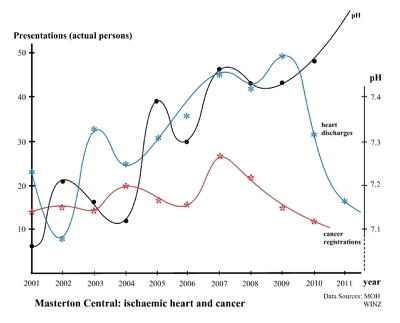
The heart failure graph can be expected to cross over the cancer graph in the near future as the incidence of heart failures falls off faster than the incidence of cancers.
Ionisation between a metal water pipe and a mains transformer neutral occurs as an alternative path to conduction through earth. This latter path has a relatively high resistance which favours the use of ionisation as an alternative return path. There are multiple return paths for electric power but it is ionisation which is most likely to be involved in the addition process. My proposal is that ionisation of water pipes is related to valency change of hydronium such that the oxygen at the core of the hydronium is moved to the outside from where it can bond to the electron hole formed by oxidation, an OH component of hydronium being attached and the balance of the hydronium parting company.
Ionisation between a metal water pipe and a mains transformer neutral occurs as an alternative path to conduction through earth. This latter path has a relatively high resistance which favours the use of ionisation as an alternative return path. There are multiple return paths for electric power but it is ionisation which is most likely to be involved in the addition process. My proposal is that ionisation of water pipes is related to valency change of hydronium such that the oxygen at the core of the hydronium is moved to the outside from where it can bond to the electron hole formed by oxidation, an OH component of hydronium being attached and the balance of the hydronium parting company.

The material you read here is covered in more detail in my new book, "Cancer, the inadmissible truth".
The EPA has recommended filtration as a safe alternative to chemical dosing. The following is an outline of that method of water treatment. Water suppliers are probably not that enthusiastic to follow this recommendation so there is a real need to lobby your local water supplier to make these improvements.
The EPA's recommended log3 filtration
Log3 filtration refers to a 99.9% reduction in bugs in a water supply. To achieve this level of filtration requires filters of 1 micron nominal (3 microns absolute). These filter out harmful bugs such as ecoli, cholera, crypotsporidium, giardia and so on.
Chlorination does not successfully control or kill cysts such as cryptosporidium and giardia so moving to filtration as an alternative is not only safe but is also a more complete and better form of water treatment. If there is any doubt at all on the completeness of log 3 filtration the "catch all" is point-of-use filtration. Point-of-use filtration are underbench filters or similar which filter to 1 micron in homes and businesses. This acts to safeguard against cross contamination between water and sewer systems in the case of leaks (although, of course, one would hope that maintenance of these systems is kept up to scratch).
Conclusion
Thank you for visiting my web site.
My old site can be found here, and I hope to extend this new site to include asbestos water pipe and fluoride, the latter being both in water supplies and dental materials. Fluoride appears to be having a very significant effect on the lymphoblastic blood cancer group and is worthy of greater attention as an emerging cancer epidemic.
For Masterton residents, an update of happenings is available here.
I hope the information you read here has made you more aware of the need to lobby your local water supplier, a difficult and frustratingly slow task at times, or to quietly secure for yourself a safe personal supply of water. If taking the latter path my book will help to identify the qualities required of a safe water supply.
The EPA has recommended filtration as a safe alternative to chemical dosing. The following is an outline of that method of water treatment. Water suppliers are probably not that enthusiastic to follow this recommendation so there is a real need to lobby your local water supplier to make these improvements.
The EPA's recommended log3 filtration
Log3 filtration refers to a 99.9% reduction in bugs in a water supply. To achieve this level of filtration requires filters of 1 micron nominal (3 microns absolute). These filter out harmful bugs such as ecoli, cholera, crypotsporidium, giardia and so on.
Chlorination does not successfully control or kill cysts such as cryptosporidium and giardia so moving to filtration as an alternative is not only safe but is also a more complete and better form of water treatment. If there is any doubt at all on the completeness of log 3 filtration the "catch all" is point-of-use filtration. Point-of-use filtration are underbench filters or similar which filter to 1 micron in homes and businesses. This acts to safeguard against cross contamination between water and sewer systems in the case of leaks (although, of course, one would hope that maintenance of these systems is kept up to scratch).
Conclusion
Thank you for visiting my web site.
My old site can be found here, and I hope to extend this new site to include asbestos water pipe and fluoride, the latter being both in water supplies and dental materials. Fluoride appears to be having a very significant effect on the lymphoblastic blood cancer group and is worthy of greater attention as an emerging cancer epidemic.
For Masterton residents, an update of happenings is available here.
I hope the information you read here has made you more aware of the need to lobby your local water supplier, a difficult and frustratingly slow task at times, or to quietly secure for yourself a safe personal supply of water. If taking the latter path my book will help to identify the qualities required of a safe water supply.
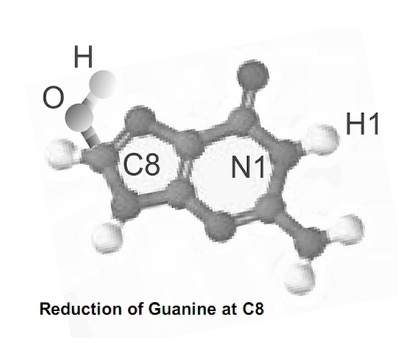
For a firefox friendly version click here.
Link here to read the Introduction to the book,"Cancer the Inadmissible Truth."